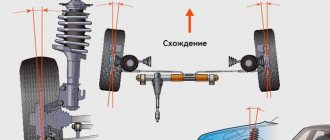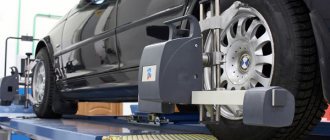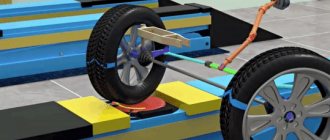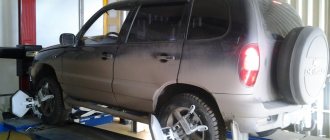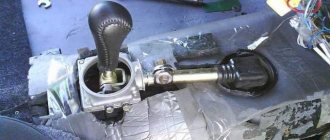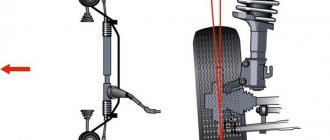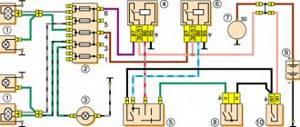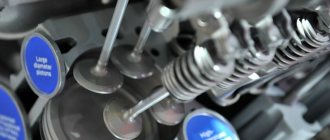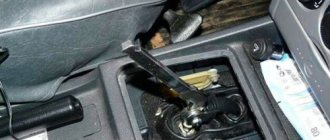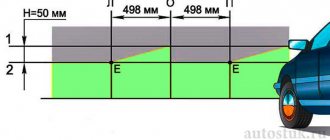CAMBER ALIGNMENT ON A VAZ 2109 WITH YOUR OWN HANDS
After any repair of the suspension or steering on VAZ 2109 vehicles, it is necessary to adjust the camber and toe angle of the front wheels.
This procedure is extremely important, because if you do not carry it out, in the best case, the car will “eat up” the rubber, and in the worst case, it will constantly be pulled to the side while driving, which is extremely dangerous, since it is fraught with an accident.
Typically, car enthusiasts prefer to go to a car service center because they have all the necessary equipment. However, some people want to try to adjust the wheel alignment themselves or cannot afford the extra expenses. How to carry out this operation yourself on a VAZ 2109? We will answer this question in our article today.
Camber - alignment - why is the procedure needed?
Before I give you step-by-step instructions, let's figure out what kind of wheel alignment procedure this is, what are the wheel alignment angles of the VAZ 2109 and how does the car's behavior on the road depend on them?
To ensure good stability and controllability of the car, the front wheels are installed at certain angles relative to the body and suspension elements. Three parameters are adjusted: toe-in, wheel camber angle, and the longitudinal inclination of the steering axis.
The casting angle of the steering axis is the angle between the vertical and the line passing through the centers of rotation of the ball joint and the bearing of the telescopic strut support, in a plane parallel to the longitudinal axis of the vehicle. It helps stabilize the steered wheels in the direction of straight motion. This angle depends on the number of adjusting washers at the ends of the extension. To decrease the angle, washers are added, and to increase it, they are removed. When installing/removing one washer, the angle changes by approximately 19′. Symptoms of deviation of the angle from the norm: the car pulls to the side when driving, different forces on the steering wheel in left and right turns, one-sided tread wear.
Angle of axle rotation when turning VAZ 2109
Wheel camber angle is the angle between the plane of rotation of the wheel and the vertical. It promotes the correct position of the rolling wheel during suspension operation. The angle is adjusted by turning the top bolt securing the telescopic strut to the steering knuckle. If this angle deviates greatly from the norm, the vehicle may deviate from straight-line motion and cause one-sided wear of the tread.
Camber angle of VAZ 2109 wheels
Wheel toe is the angle between the plane of rotation of the wheel and the longitudinal axis of the car. Toe can also be defined as the difference in distances between the flanges of the rims, measured from the rear and front of the wheels at the level of their centers. Wheel toe ensures the correct position of the steered wheels at various vehicle speeds and turning angles.
Wheel alignment VAZ 2109
The toe-in is changed by rotating the adjusting couplings with the locknuts of the tie rod ends loosened. Before adjustment, the steering rack is set to the middle position (steering wheel spokes are horizontal). Signs of toe deviation from the norm: severe saw-tooth wear of tires in the transverse direction (even with small deviations), squealing of tires when cornering, increased fuel consumption due to high rolling resistance of the front wheels (the vehicle's run-out is much less than required).
Caster adjustment
Caster is set by the manufacturer. It is determined by the design and geometry of the parts. If you had a deflection, then most likely there was a blow that dislodged it. And you need to go to a service center for diagnostics and replacement of deformed parts. In 98% of cases, caster adjustment is not provided, which may be a revelation for some. Caster only complements the behavioral characteristics of each individual car; angles are individual.
An example is Mercedes-Benz, their caster angle is set to +10-12˚ and they have excellent maneuverability, controllability and road stability. This effect is achieved by changing the camber. With such a tilt, the camber angles will be greater than with a tilt of 1-2 degrees and the car will not lose maneuverability and will maintain stability. So the goal was achieved in a non-standard way.
Pitch angle (caster) is the angle between the steering axis of the wheel and the vertical in a side view. It is considered positive if the axis is tilted backward relative to the direction of movement.
Camber is the inclination of the wheel plane to the perpendicular restored to the plane of the road. If the top of the wheel is tilted outward of the car, then the camber angle is positive, and if it is tilted inward, it is negative.
Toe-in is the angle between the longitudinal axis of the vehicle and the plane passing through the center of the steering wheel tire. Toe is considered positive if the planes of rotation of the wheels intersect in front of the car, and negative if, on the contrary, they intersect somewhere behind.
When is it recommended to carry out alignment - VAZ 2109
Various sources recommend adjustments at approximately 12-15 thousand kilometers, or once a year. Sometimes there are cases when it is necessary to perform such an operation ahead of schedule. The reason for this in most cases is the condition of our roads. It is enough to “catch” a good pothole once to require checking and adjusting the camber and toe of the front wheels.
Carrying out work on adjusting the front wheels of a VAZ 2109
If the owner plans to use his car for a long time without any problems, then it is not worth saving on this operation. After each replacement of ball joints, silent blocks, steering rods, shock absorbers, it is necessary to check and adjust the camber and toe of the wheels.
Tire wear due to incorrect camber of VAZ 2109
Performing this operation today is quite simple. You just need to go to a service center that performs such an operation, and specialists will quickly and efficiently complete this work. But there are times when such work must be done independently in a garage.
Self-adjustment
On rear-wheel drive Zhiguli cars, for example, VAZ-2105 or 2107, the angle is 3 degrees 30 minutes, plus or minus 30 minutes. On front-wheel drive models, for example, Priora, VAZ-2109, VAZ-2110, this angle is smaller, only 1 degree 30 minutes, plus or minus 30 minutes. If the caster of one front wheel of a VAZ-2105 is 3 degrees exactly, and the other is 4 degrees exactly, which is the norm by factory standards, the car will inevitably pull to the side.
Adjusting the caster angle is done by removing or adding washers on the suspension braces. The maximum number of washers allowed is two in the front and four in the rear, with the addition or removal of one shim changing the caster angle by 19 minutes. When adding washers, it is necessary to turn them over with their chamfers facing the thrust end of the stretcher.
Of course, this procedure cannot be carried out in a garage. Adjusting the caster angle is carried out only in conjunction with adjusting the camber and toe of the wheels, otherwise the suspension settings will be disrupted and the car may behave completely unpredictably.
To increase it, tuning enthusiasts remove the standard strut supports and install SS-20 supports instead. on front-wheel drive VAZ cars, including Priora, such a replacement, coupled with installing the maximum number of washers, allows you to increase the angle to 3 degrees. At the same time, the controllability of the car changes noticeably, the overall effect is positive.
Often, to improve handling, it is enough to simply replace the strut supports with the same ones. Despite the fact that the caster angle will not change significantly, the result will be, as they say, obvious. It's all about physical wear and tear. A signal that the supports need to be replaced is a low, thumping sound that occurs when driving on an uneven road at low speed. You can confirm the diagnosis by rocking the car and seeing if the struts dampen vibrations equally on the left and right sides. If not, you need to change the supports.
When choosing new strut supports, you should not choose the cheapest ones. It's better to buy either standard ones or SS-20. The latter are much more expensive, but they will also last much longer, and due to the fact that replacing supports is a complex and time-consuming task, the overpayment may be completely justified.
» alt=»»>
Pitch angle (caster) is the angle between the steering axis of the wheel and the vertical in a side view. It is considered positive if the axis is tilted backward relative to the direction of movement.
Camber is the inclination of the wheel plane to the perpendicular restored to the plane of the road. If the top of the wheel is tilted outward of the car, then the camber angle is positive, and if it is tilted inward, it is negative.
Read more: BMW trunk control unit
Toe-in is the angle between the longitudinal axis of the vehicle and the plane passing through the center of the steering wheel tire. Toe is considered positive if the planes of rotation of the wheels intersect in front of the car, and negative if, on the contrary, they intersect somewhere behind.
Below are experiments to understand how wheel adjustments affect the behavior of the car. The Samara VAZ-2114 was chosen for the tests - most modern foreign cars do not burden the owner with a range and choice of adjustments. All the parameters there are set by the manufacturer and it is quite difficult to influence them without structural modifications. The new car has an unexpectedly light steering and slurred behavior on the road. The wheel alignment angles are within the tolerance range, with the exception of the longitudinal angle of inclination of the left wheel (caster) axis of rotation. In relation to the front suspension of a domestic front-wheel drive car, setting the angles always begins with adjusting the caster. It is this parameter, on the one hand, that is decisive for the rest, and on the other hand, it has a lesser effect on tire wear and other nuances associated with the rolling of the car. Moreover, this operation is the most labor-intensive - I think that is why they “forget” about it at the factory. Only then, having dealt with the longitudinal angles, does a competent master begin to adjust the camber, and then the toe-in.
Do-it-yourself wheel alignment adjustment for VAZ 2109
In order to correctly adjust the wheel alignment on a VAZ 2109, you must perform the following procedure:
- We install the car on a horizontal platform;
- We mark a couple of marks on the wheel rim with chalk (the first from above, the second from below);
- Next, you need to attach the cord from which the plumb line is suspended to the wing. After that, using the marks, using a ruler, measure the distance from the cord to the rim and to the top mark, then measure the distance to the bottom mark. The distances should differ by no more than 3 mm;
- For greater accuracy of calculations, the car needs to be rolled by turning the wheel 90 degrees. We put two more marks on the wheel, and again perform the same measurements;
- Similar actions are performed on the second wheel, and all measurement results are recorded;
- Next, you need to turn the car 180 degrees and repeat all the measurements described above;
- We dismantle the wheel, and then, using a pair of 19mm wrenches, unscrew the 2 bolts that secure the shock absorber strut bracket to the steering knuckle.
- Using the “19” key, we move the steering knuckle, inward or outward, to the required distance, achieving the required camber angle;
- We tighten the bolts and mount the wheel back, after which we remove the jack. We rock the car a couple of times, leaning against the fender. Then we repeat all the measurements made earlier and write down their results;
- Moving a few meters away from the car, we study the location of the front wheels in comparison with the rear wheels.
- The camber angle on cars with rear-wheel drive should be from +1 to +3 mm.
- The camber angle on cars with front-wheel drive should be from -1 to +1 mm
In order to correctly adjust the toe angle of the VAZ 2109 wheels, all measurements must be made with a telescopic ruler, located in the inspection hole. In this case, the steering wheel should be positioned as if the car was driving straight.
- Using chalk, we apply marks on each of the wheels (left and right), on the inside, as close as possible to the disks;
- We stretch and install the telescopic ruler, resting its ends against the marks made earlier. This is done so that the surface of the ruler does not touch either the suspension or the body;
- Gently shaking the ruler, we combine the “zero” of the moving scale with the pointer located on the fixed part of the ruler, and fix this position;
- We roll the car forward, while the fixed ruler will move backward along with the wheels. It is necessary to stop until it touches the body or suspension;
- We record the received readings.
The distance between the front and rear wheels should be the same. If equality of distances is not observed, then the steering rods need to be adjusted. The adjustment is made in the direction of lengthening the steering rods if the rear wheels are located closer to each other than the front ones. Conversely, the tie rods are shortened when the rear wheels are positioned further apart than the front wheels.
Step-by-step instructions for adjusting steering rods on a VAZ-2109
Well, all that remains is a small matter of adjusting the steering rods. For this:
- Lightly unscrew the nuts on the steering rods using a 27 wrench. When unscrewing, pay attention to the fact that the nuts with marks on the edges are left-hand threaded;
- Using the “24” key, we begin to turn the clutch, changing the length of the rod, while controlling the horizontal position of the steering spokes;
- We set the moving scale located on the ruler to “0” and move the car back;
- Once the reading is between -1 and +1 millimeters, the adjustment procedure can be completed. However, if you want to make sure that you did everything correctly, you can now drive the car forward, while the measurement indicators should remain within the same limits.
After all the manipulations done to adjust the wheel alignment, all that remains is to look one by one, from the front wheels to the alignment of the rear wheels. If the steering wheel spoke is horizontal, you will see what (right or left) offset the wheels have. With a strongly pronounced displacement, one of the rods is unscrewed by several turns, and the other is tightened (by the same number of turns). Thus, the offset is eliminated completely.
Option 3
Excessively “positive” camber. It is undesirable to change it without toe correction, therefore positive toe is also introduced. The steering wheel became lighter again, the responses when entering a turn became lazier, and the lateral movement of the body increased. But there is no catastrophic deterioration in character. However, when simulating an extreme situation, the “steering feel” is lost. With the advent of slips, unexpectedly early it becomes difficult to get into the given corridor at the “rearrangement” and the car begins to slide too early. In fast corners, the strongest slip of the front axle dominates.
Read more: How to clean leather chairs
How to make a wheel alignment yourself on a VAZ 2109
You can adjust the wheel alignment angles of your car with your own hands using available tools and simple devices. In this material we will talk about how to do wheel alignment yourself at home, and what difficulties are most often encountered when adjusting wheel alignment angles.
Incorrect alignment adjustment can cause, for example, rapid wear of tires, or the fact that when driving in a straight line, the car will pull to the left or to the right.
At the end of this article you will find a video that explains and shows in detail everything you need to know about wheel alignment.
First, let's look at the theory: wheel alignment - what is it? What are the wheel alignment angles and how does the car’s behavior on the road depend on them?
Wheel alignment - what is it?
Camber is the angle between the vertical and the plane of the wheel. It ensures reliable contact of the tire with the road (see picture above).
Toe is the angle between the direction of travel and the plane of rotation of the wheel. The stability of the car in corners and tire wear depend on it.
On rear-wheel drive cars, the wheels should be slightly turned towards each other - this is called positive toe. When moving, they move apart and become parallel. For front-wheel drive vehicles, on the contrary, the toe-in should be negative (see the diagram below). Caster is the longitudinal inclination angle of the king pin. This parameter very rarely needs adjustment, only on a newly assembled front suspension from new parts, so we will not consider its adjustment.
Repairing the suspension or steering (replacing the same shock absorbers or steering joint) leads to a significant change in the wheel alignment angles. Daily use of the car also makes adjustments to these parameters over time, so the need to adjust the wheel alignment periodically arises.
It is best to adjust wheel alignment twice a year, during seasonal tire changes. During this time, you will fall into a hole more than once or run over a curb, causing the chassis to become loose and the angles to change. Timely alignment adjustment will cost much less than a set of new tires.
In 1955, American engineer Lee Hunter developed the first wheel alignment stand. Sensors mounted on the wheels sent focused beams of light and accurately measured angles. That's why the stand was called optical. But already in 1969 it was connected to a computer, and in 1995, 3D technology was first used to measure and adjust angles.
True, Soviet car enthusiasts managed without any stands or computers - using wrenches, calipers, thread and a plumb line, they adjusted the camber and toe angles with their own hands.
Instructions for adjusting wheel alignment yourself
Before you begin adjusting the camber and toe angles, it is imperative to check the vehicle's chassis. If repairs are needed, then doing a wheel alignment is pointless. The steering and suspension must be in perfect order.
Pay attention to three points on which the wheel alignment angles on a car greatly depend:
Serviceability of the chassis (read more about car suspension diagnostics). Tire pressure. Loading the machine. Be sure to check the tire pressure before adjusting the wheel alignment and make sure that you haven’t accidentally forgotten a couple of bags of potatoes or cement in the trunk
